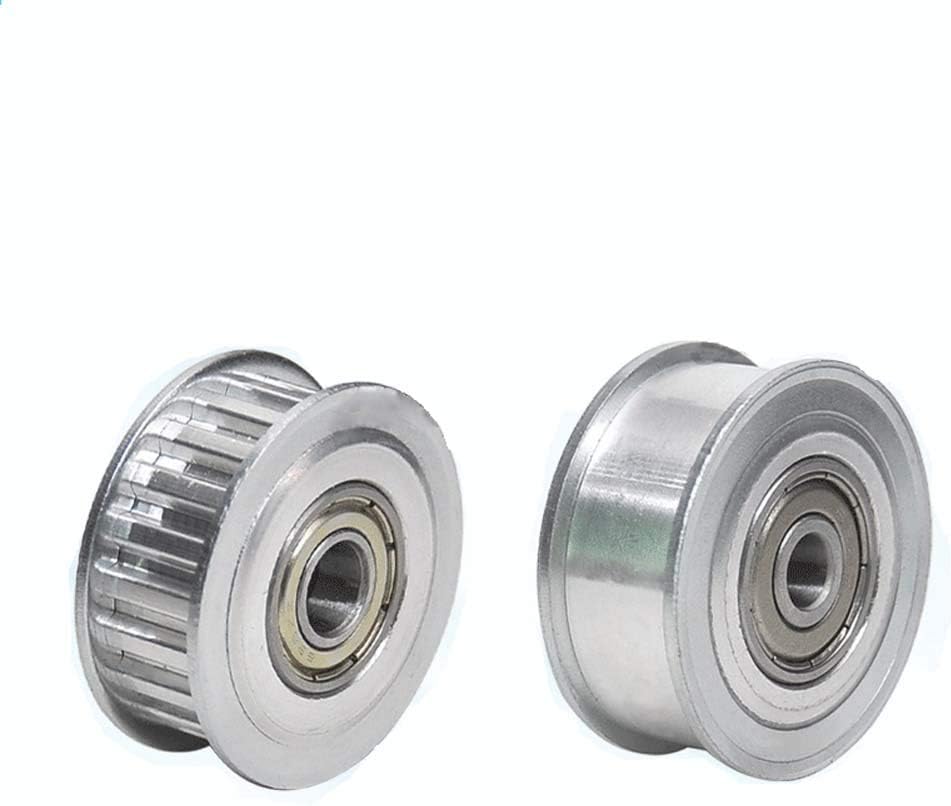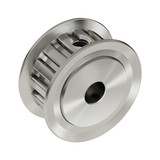Product Description
Product Description
Manufacturer of pulley
European standard and American standard
With high quality and competitive price
Timing belt pulley:
1, Models: XL037, L050, L075, L100, H075, H100, H150, H200, H300, XH200, XH300, XH400HTD: 3M-09, 3M-15, 5M-09, 5M-15, 5M-25, 8M-20, 8M-30, 8M-50, 8M-85, 14M-40, 14M-55, 14M-85, 14M-115, 14M-170, T2.5, T5, T10, T20, AT2.5, AT5, AT10, AT20
2, Pilot bore, taper bore, QD bore
3, Material: 1045 steel, aluminum and stainless steel
4, Surface finish: Black oxidized phosphate, anodized, zinc-plated
5, Standard toothed bars are also available.
Detailed Photos
Our Advantages
Packaging & Shipping
| WHY CHOOSE US |
| Comprehensive Product Portfolio We produce and supply a wide range of power transmission products including drive chains, leaf chains, conveyor chains, agricultural chains, sprockets, and couplings. This one-store-for-all shopping experience will significantly reduce your searching costs while guarantee youfind what you want at 1 click. Value Choice Products Our products are the best combination of quality and price, and you get what Seasoned Sales Associates and Engineers We have 15 seasoned sales associates and 5 engineers; 100% Customer Retention Rate Our regular customers from overseas come back not just for our |
| FAQ |
| Q1: What’s your average lead time? A: It varies. Our regular end-to-end lead time is 1-2 months.. We also provide express shipments for rush orders. For details,please consult our sales associate. Q2: Is your price better than your competitors given the same quality? Q4: Can we inspect the goods before shipment? Q5: What kind of payment method is acceptable for your mill? Q6: What if I have any other questions? |
|
Shipping Cost:
Estimated freight per unit. |
To be negotiated |
|---|
| Certification: | ISO |
|---|---|
| Pulley Sizes: | Type E |
| Manufacturing Process: | Casting |
| Customization: |
Available
| Customized Request |
|---|

Can XL pulleys be integrated into existing mechanical systems for upgrades?
Yes, XL pulleys can be integrated into existing mechanical systems for upgrades. Here is a detailed explanation of the integration process and the benefits of upgrading with XL pulleys:
1. Compatibility:
XL pulleys are designed to be compatible with standard timing belts, making them suitable for integration into existing systems that utilize timing belt drives. The pulleys are available in various sizes and tooth profiles, allowing for easy replacement and compatibility with different belt lengths and widths.
2. Improved Performance:
Integrating XL pulleys into an existing mechanical system can lead to improved performance. XL pulleys offer advantages such as higher torque capacity, increased speed capabilities, and better power transmission efficiency compared to smaller pulley sizes. Upgrading to XL pulleys can enhance the system’s overall performance, allowing for higher loads, faster speeds, and improved efficiency.
3. Enhanced System Precision:
XL pulleys are known for their precise tooth profiles and accurate dimensional control. By integrating XL pulleys, the system can benefit from improved positional accuracy and reduced backlash. This is particularly important in applications where precise positioning or synchronization is crucial, such as CNC machines, robotics, or high-precision conveyors.
4. Customization Options:
XL pulleys offer customization options, allowing them to be tailored to specific system requirements. Manufacturers can modify pulley dimensions, bore sizes, keyway configurations, or tooth profiles to match the existing system’s needs. This customization capability ensures a seamless integration into the system without the need for significant modifications or adaptations.
5. Cost-Effective Upgrade:
Integrating XL pulleys into an existing mechanical system can be a cost-effective upgrade option. Since the system’s core components, such as the shafts and bearings, remain unchanged, the upgrade primarily involves replacing the existing pulleys with XL pulleys. This reduces the cost and complexity associated with a complete system overhaul while still providing significant performance improvements.
6. Ease of Installation:
The integration of XL pulleys into existing systems is relatively straightforward. The process typically involves removing the old pulleys and replacing them with the new XL pulleys. As long as the pulley dimensions and tooth profiles are compatible, installation can be completed with basic tools and minimal downtime.
7. System Scalability:
XL pulleys offer scalability options, allowing for future system expansions or modifications. If the mechanical system requires capacity upgrades or changes in operating conditions, integrating XL pulleys provides flexibility for system scalability. Additional pulleys can be easily added or replaced to accommodate the evolving needs of the system.
In summary, XL pulleys can be successfully integrated into existing mechanical systems for upgrades. The compatibility, improved performance, enhanced precision, customization options, cost-effectiveness, ease of installation, and system scalability make XL pulleys a viable choice for upgrading mechanical systems to achieve better performance, efficiency, and adaptability.

Are there safety considerations when working with XL pulley systems?
Yes, there are several safety considerations that should be taken into account when working with XL pulley systems. Here are some important safety considerations:
1. Lockout/Tagout Procedures:
Before performing any maintenance or repair tasks on a power transmission system involving XL pulleys, it is crucial to follow proper lockout/tagout procedures. This involves isolating the system from its power source and ensuring that it cannot be energized accidentally. Lockout/tagout procedures help prevent unexpected startup of the system, which could cause serious injuries.
2. Personal Protective Equipment (PPE):
Wear appropriate personal protective equipment when working with XL pulley systems. Depending on the specific task and potential hazards, PPE may include safety glasses, gloves, hearing protection, and protective clothing. PPE helps protect against potential injuries from contact with moving parts, flying debris, or noise exposure.
3. Training and Competence:
Ensure that personnel working with XL pulley systems are adequately trained and competent to perform their tasks safely. They should be familiar with the proper procedures for installation, operation, and maintenance of the pulleys. Training should also cover the identification and understanding of potential hazards associated with the system and how to mitigate them.
4. Machine Guards:
Install appropriate machine guards and protective enclosures around the XL pulley systems to prevent accidental contact with moving parts. Guards help minimize the risk of entanglement, pinch points, or injuries caused by the rotating pulleys or the timing belt.
5. Risk Assessment:
Conduct a thorough risk assessment of the XL pulley system and its surrounding environment. Identify and evaluate potential hazards, such as pinch points, sharp edges, or electrical hazards. Implement control measures to mitigate the identified risks, such as implementing interlocks, providing warning signs, or establishing safe work procedures.
6. Regular Maintenance:
Perform regular maintenance and inspection of the XL pulley system to ensure its safe operation. This includes checking for any signs of wear, damage, or misalignment, as well as verifying the integrity of guards and safety devices. Address any maintenance issues promptly to prevent potential safety hazards.
It is important to consult relevant safety standards, guidelines, and regulations specific to your industry and jurisdiction when working with XL pulley systems. Adhering to these safety considerations will help protect personnel from injuries and create a safe working environment when interacting with XL pulley systems.

What materials are typically used in the construction of XL pulleys?
The construction of XL pulleys involves the use of various materials, depending on the specific application requirements, load capacity, and cost considerations. Here are the materials commonly used in the construction of XL pulleys:
1. Aluminum:
Aluminum is a lightweight and corrosion-resistant material commonly used in XL pulleys. It offers good strength-to-weight ratio and excellent machinability, making it suitable for many applications. Aluminum pulleys are often used in robotics, automation systems, and other applications where weight reduction is desirable.
2. Steel:
Steel is a durable and robust material used in XL pulleys for applications that require higher load capacity and strength. Steel pulleys provide excellent resistance to wear and can handle heavy-duty applications. They are commonly used in industrial machinery, automotive components, and other demanding applications.
3. Plastic:
Plastic pulleys are lightweight, cost-effective, and offer good resistance to chemicals and corrosion. They are commonly made from materials such as nylon, acetal, or polycarbonate. Plastic pulleys are used in a variety of applications, including 3D printers, medical devices, and smaller-scale machinery.
4. Composite Materials:
Composite materials, such as fiberglass-reinforced polymers, are sometimes used in the construction of XL pulleys. These materials offer a combination of properties, including high strength, low weight, and resistance to corrosion. Composite pulleys are often used in aerospace, marine, and other specialized applications.
5. Stainless Steel:
Stainless steel is chosen for XL pulleys when corrosion resistance is of utmost importance. Stainless steel pulleys exhibit excellent resistance to rust and corrosion, making them suitable for applications in harsh environments or where exposure to moisture or chemicals is expected.
It’s important to note that the material selection for XL pulleys depends on factors such as the application requirements, load capacity, environmental conditions, and budget constraints. Manufacturers consider these factors to determine the most suitable material for achieving the desired performance and reliability in specific applications.


editor by CX
2023-09-23